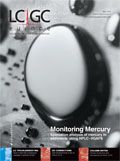Vol 26 No 5 LCGC Europe May 2013 Regular Issue PDF
Click the title above to open the LCGC Europe May 2013 regular issue, Vol 26 No 5, in an interactive PDF format.
Articles in this issue

HPLC Column Selection
New Chromatography Columns and Accessories at Pittcon (Part 1)
Speciation Analysis of Mercury in Sediments by HPLC Using HPLC Hyphenated to Vapour Generation Atomic Fluorescence Spectrometry Following Microwave-Assisted Extraction
Event News: Euroanalysis 2013
New Gas Chromatography Products for 2013
Gradient Elution, Part III: Surprises
Vol 26 No 5 LCGC Europe May 2013 Regular Issue PDF
Recent Videos
The Current Challenges Mitigating PFAS
The Role of PFAS Impacting Carbon Fluxes
Understanding the Movement of PFAS in the Environment
Where Will Your Data Take You? How Modern Lab Informatics Unlocks Your Potential
The Interactions Between Bacterial Communities and PFAS
The Challenges of Characterizing PFAS in the Environment
Inside the Laboratory: The Mead Group at UNC Wilmington and the North Carolina PFAS Testing Network
Exploring Molecular Dynamics: An Interview with Ezgi Gürler of FeMS
Developing Advanced Fragmentation Schemes: An Interview with Ezgi Gürler of FeMS
Advancing Science Through Diversity: A Conversation with Women in Chromatography, Part 5
Related Content
Regulatory Deadlines and Supply Chain Challenges Take Center Stage in Nitrosamine Discussion
April 10th 2025Article
During an LCGC International peer exchange, Aloka Srinivasan, Mayank Bhanti, and Amber Burch discussed the regulatory deadlines and supply chain challenges that come with nitrosamine analysis.










